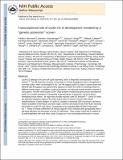Transcriptional role of cyclin D1 in development revealed by a “genetic-proteomic” screen
Author(s)
Bienvenu, Frederic; Jirawatnotai, Siwanon; Elias, Joshua E.; Meyer, Clifford A.; Mizeracka, Karolina; Marson, Alexander; Frampton, Garrett M.; Cole, Megan F.; Odom, Duncan; Odajima, Junko; Geng, Yan; Zagozdzon, Agnieszka; Jecrois, Marie; Young, Richard A.; Liu, X. Shirley; Cepko, Constance L.; Gygi, Steven P.; Sicinski, Piotr; ... Show more Show less
DownloadYoung_Transcriptional role.pdf (1.535Mb)
OPEN_ACCESS_POLICY
Open Access Policy
Creative Commons Attribution-Noncommercial-Share Alike
Terms of use
Metadata
Show full item recordAbstract
Cyclin D1 belongs to the core cell cycle machinery, and it is frequently overexpressed in human cancers[superscript 1, 2]. The full repertoire of cyclin D1 functions in normal development and oncogenesis is unclear at present. Here we developed Flag- and haemagglutinin-tagged cyclin D1 knock-in mouse strains that allowed a high-throughput mass spectrometry approach to search for cyclin D1-binding proteins in different mouse organs. In addition to cell cycle partners, we observed several proteins involved in transcription. Genome-wide location analyses (chromatin immunoprecipitation coupled to DNA microarray; ChIP-chip) showed that during mouse development cyclin D1 occupies promoters of abundantly expressed genes. In particular, we found that in developing mouse retinas—an organ that critically requires cyclin D1 function[superscript 3, 4]—cyclin D1 binds the upstream regulatory region of the Notch1 gene, where it serves to recruit CREB binding protein (CBP) histone acetyltransferase. Genetic ablation of cyclin D1 resulted in decreased CBP recruitment, decreased histone acetylation of the Notch1 promoter region, and led to decreased levels of the Notch1 transcript and protein in cyclin D1-null (Ccnd1-/-) retinas. Transduction of an activated allele of Notch1 into Ccnd1-/- retinas increased proliferation of retinal progenitor cells, indicating that upregulation of Notch1 signalling alleviates the phenotype of cyclin D1-deficiency. These studies show that in addition to its well-established cell cycle roles, cyclin D1 has an in vivo transcriptional function in mouse development. Our approach, which we term ‘genetic–proteomic’, can be used to study the in vivo function of essentially any protein.
Description
Author manuscript: 2010 September 22.
Date issued
2010-01Department
Massachusetts Institute of Technology. Department of BiologyJournal
Nature
Publisher
Nature Publishing Group
Citation
Bienvenu, Frédéric et al. “Transcriptional Role of Cyclin D1 in Development Revealed by a Genetic–proteomic Screen.” Nature 463.7279 (2010): 374–378.
Version: Author's final manuscript
ISSN
0028-0836
1476-4687